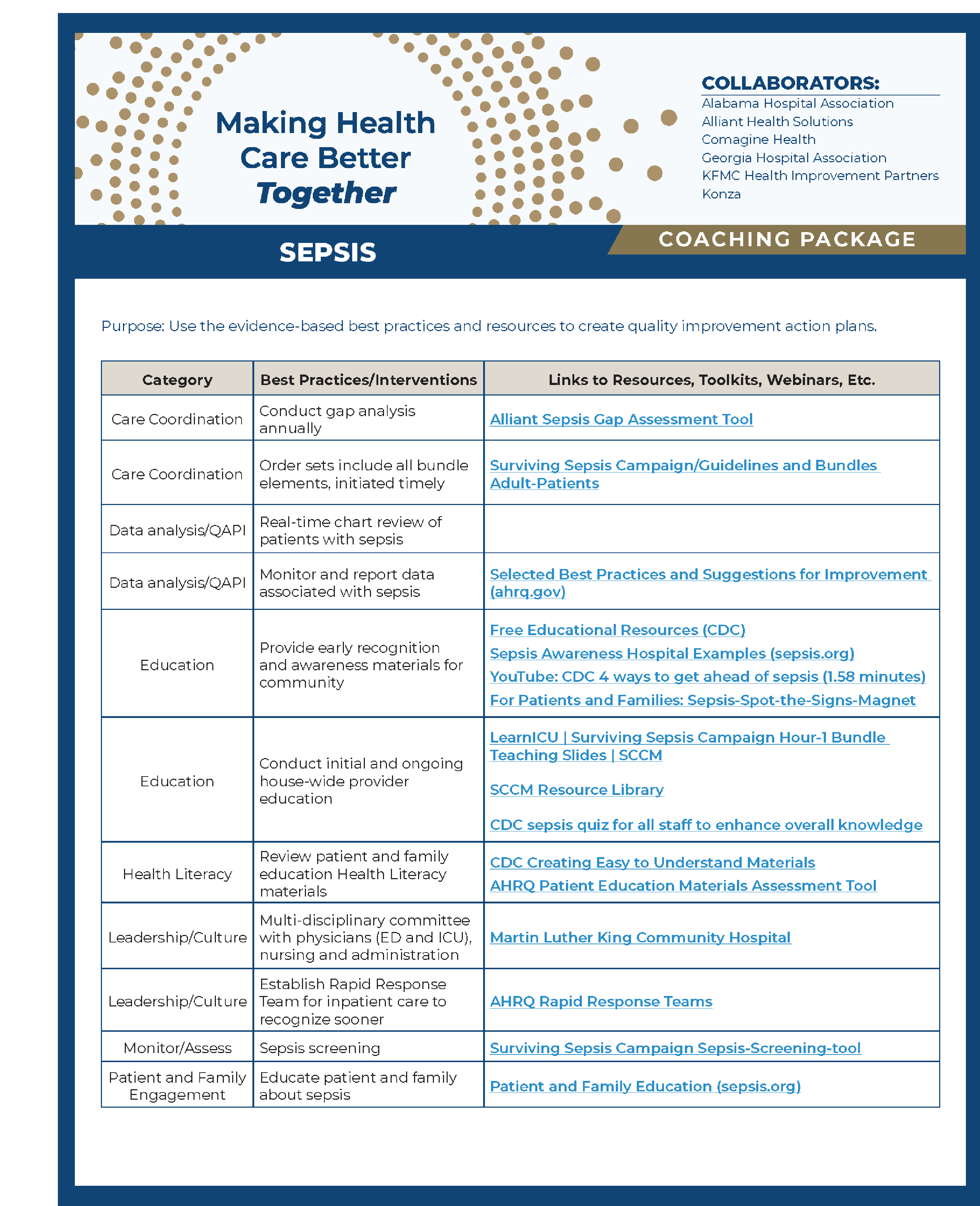At least 1.7 million adults in America develop sepsis. Anyone can develop sepsis; however, adults 65 or older are considered high risk.[1] Alliant Health Solutions (Alliant), a Centers for Medicare & Medicaid Services (CMS) Hospital Quality Improvement Contractor (HQIC), provides technical assistance and education to hospitals to improve patient safety and recently worked with two hospitals to reduce sepsis mortality rates.
One critical access hospital (CAH) in Georgia achieved an 83.33 percent Relative Improvement Rate (RIR) in sepsis mortality (performance period October 2021-September 2022) compared to the baseline period of 2019. The other hospital, a 150-bed rural facility in Washington state, achieved a 11.49 percent RIR in sepsis mortality (performance period October 2021-September 2022) compared to the 2019 baseline utilizing Alliant’s provider resources and recommended interventions.
Helping Hospitals Through Multiple Interventions

Alliant’s Sepsis Coaching package was used by both hospitals to identify evidence-based best practices and resources to create quality improvement action plans. Quality improvement coaches shared coaching packages on monthly 1:1 calls with the hospitals. Top interventions were reviewed with accompanying resources as well as professional association websites. Resources in the coaching package include:
- A Sepsis Gap Assessment Tool to identify annually gaps in hospitals’ sepsis programs
- Surviving Sepsis Campaign/Guidelines and Bundles for Adult Patients that provides guidance for clinicians caring for adult patients with sepsis or septic shock
- AHRQ Post Op Sepsis Best Practices that recommends practices to prevent postoperative sepsis.
Educational resources from partners such as, Sepsis Awareness Hospital Examples sepsis.org, YouTube: CDC 4 Ways to Get Ahead of Sepsis and For Patients and Families: Sepsis-Spot-the-Signs Magnet were shared to conduct initial and ongoing house-wide provider education. Additionally, the CAH in Georgia completed a Sepsis Risk Assessment to ensure criteria that indicate a potential risk for sepsis were captured. Example criteria include history suggestive of new infection, signs and symptoms such as temperature, white blood cell count and tachycardia, organ dysfunction criteria with lab values such as creatinine, bilirubin and lactate.
The hospital team and staff participated in Alliant’s HQIC Monthly Office Hours – Infection Prevention Chats, monthly networking events structured to build knowledge, share experiences and provide support for hospital infection preventionists. Learning and Action Network events, such as Sepsis Care in 2022: Identification and Management Strategies to Optimized Patient Outcomes, and follow-up educational resources such as key takeaways and tips to begin quality improvement were also provided.
Compared to CY2019 baseline, the CAH in Georgia achieved a RIR of 83.33 percent compared to their 6 percent goal. Ten patient deaths were prevented with a cost savings estimated at $577,220 ($57,722 per harm event).
The rural hospital in Washington state utilized the tools referenced above and participated in sepsis educational events, including Alliant’s Sepsis Cohort beginning in May 2022. The patient safety cohort focused on the improvement of sepsis shock and/or sepsis mortality and associated performance metrics. Alliant suggested that the hospital participate in their sepsis cohort after demonstrating through CMS claims data an increase in sepsis mortality rate (30-day deaths per 1,000 people with Medicare admitted with a primary or secondary diagnosis of sepsis, including sepsis present on admission) to 285.71 in February 2022 and 304.35 in March 2022. After participating in the Sepsis cohort, the hospital was able to reduce their sepsis mortality rate to 176.5 in September 2022. Compared to the 2019 baseline period, the hospital achieved a 11.49 percent RIR (performance period October 2021-September 2022).
In an analysis of hospital practices, Alliant identified an opportunity for the rural hospital in Washington state to implement a new process to streamline sepsis treatment and improve SEP-1 compliance that requires all patients with suspected sepsis to be administered broad-spectrum antibiotics within 3 hours of the time a possible infection and 2 of 3 systemic inflammatory response syndrome (SIRS) criteria are documented. Alliant attributed that the rural hospital in Washington state failed SEP-1 compliance to nursing and physician documentation.
During its participation in Alliant’s sepsis cohort, the rural hospital in Washington state:
- Assigned a physician champion,
- Revised sepsis order sets, and
- Implemented a Code Sepsis within the emergency department that included a checklist and workflow.
Additionally, sepsis measures including a rational, retrospective data review with graph and improvement goal was included in the rural hospital’s Quality Assurance and Performance Improvement (QAPI) Plan and presented monthly to the Quality Management team. Online and printed sepsis education materials were created and shared with physicians and staff along with sepsis education to emergency medical care teams.
The rural hospital in Washington state improved their sepsis bundle compliance and decreased their sepsis mortality rate. Compared to CY2019 baseline, the hospital met the target sepsis mortality rate goal (6 percent) with a RIR of 11.49 percent. Six patient deaths were prevented, and cost savings are estimated at $346,332.
For more information visit Alliant HQIC website.
[1] Centers for Disease Control and Prevention
This material was prepared by The Bizzell Group (Bizzell), the Data Validation and Administrative (DVA) contractor, under contract with the Centers for Medicare & Medicaid Services (CMS), an agency of the U.S. Department of Health and Human Services (HHS). Views expressed in this material do not necessarily reflect the official views or policy of CMS or HHS, and any reference to a specific product or entity herein does not constitute endorsement of that product or entity by CMS or HHS. 12SOW/Bizzell/DVA-1110-07/18/2023

